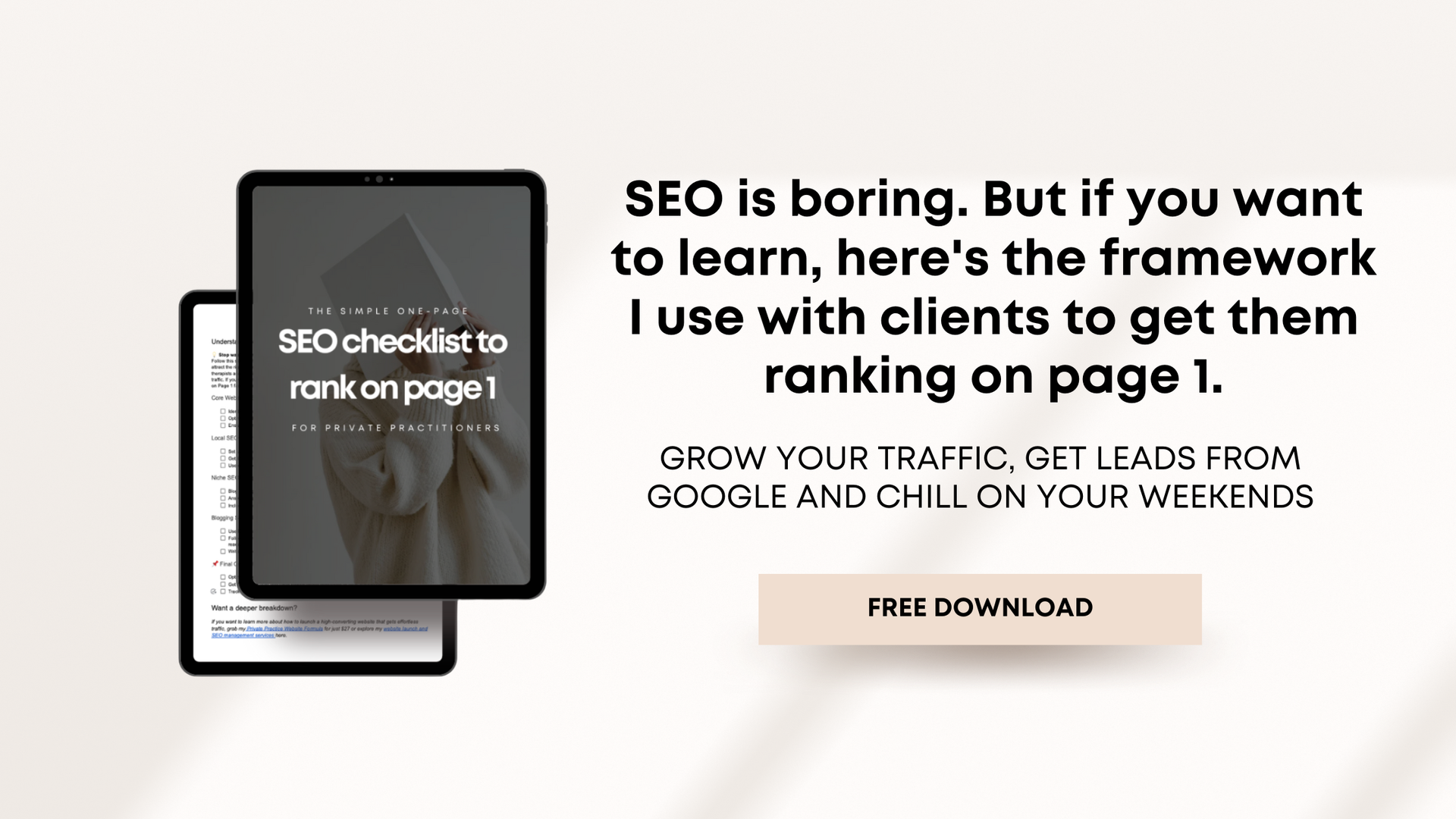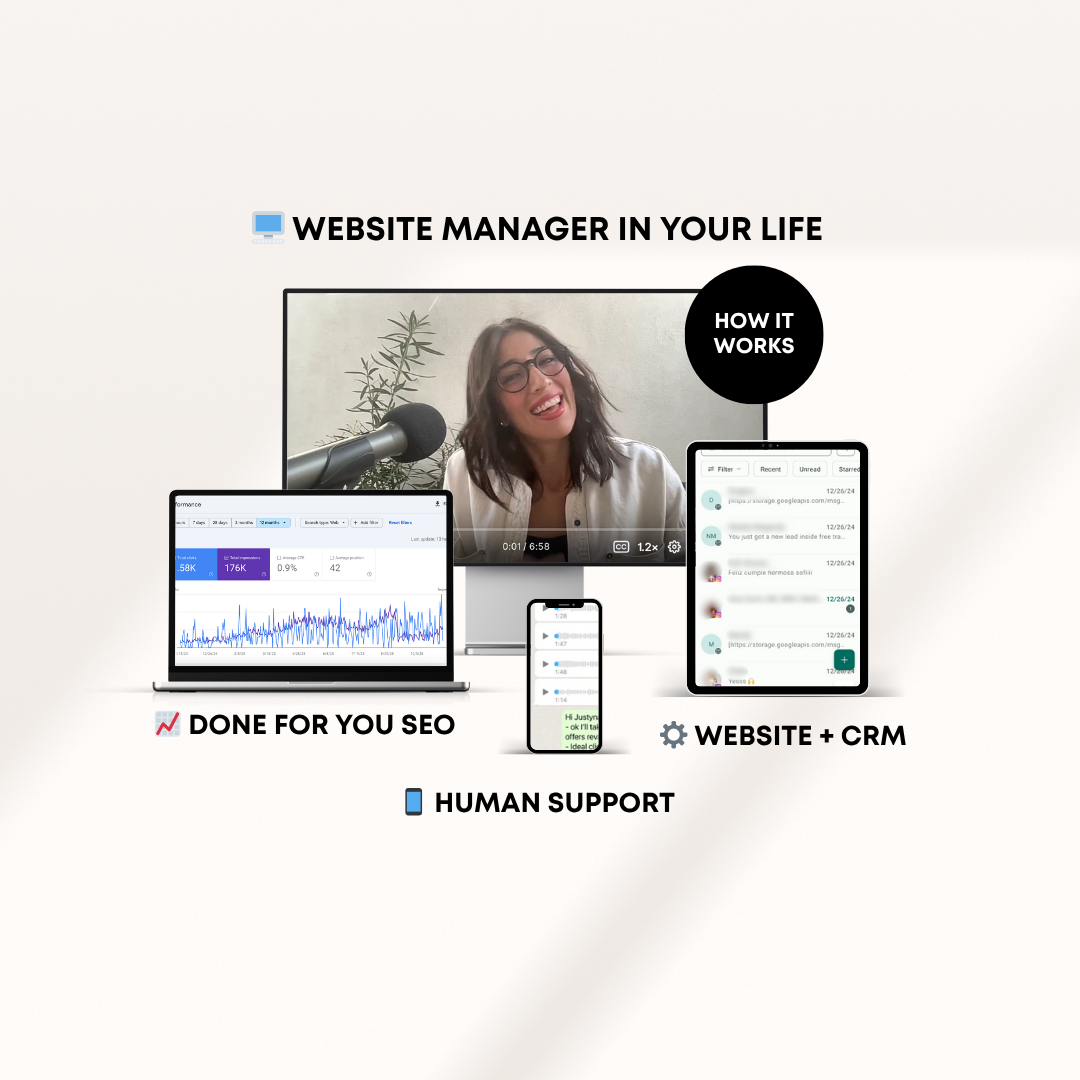The best therapist website template structure I recommend to all my clients
A therapist’s website isn’t just a digital brochure—it’s often the first impression potential clients have of your practice. It needs to build trust, communicate your expertise, and guide visitors toward booking a session effortlessly. While website templates can seem like an easy solution, not all are created equal. The wrong template can leave you with a generic, ineffective website that fails to convert visitors into clients.
In case you’re new here, I’m Natalia Maganda, and I help private practice owners create and manage a strategic, client-attracting website—without the tech headaches. If you want a website that works for you while you focus on your clients, you’re in the right place. Learn more about my web design services for therapists.
What to consider before buying a therapist website template
Before purchasing a website template, it’s important to think beyond design. While aesthetics matter, the success of your site depends on functionality, SEO, and how well it speaks to your ideal clients.
1. Does the template allow for easy customization?
Many templates look beautiful in the demo but can be difficult to personalize. If the layout is rigid or requires coding knowledge to make changes, it may not be the best fit. Your website should reflect your unique brand voice, not just a pre-made design.
2. Does it support SEO best practices?
A website that isn’t optimized for search engines is like an office hidden down an unmarked alley—no one will find it. Look for templates that show you how to set up proper meta descriptions, heading structures, mobile optimization, and fast loading speeds.
3. Does it integrate with essential systems?
Your website should work for you, not create more admin work. Make sure your template can connect with:
- Online scheduling tools
- Your sales funnel/process
- Email marketing platforms for lead capture
The best therapist website template structure for attracting and converting clients
A great therapist website isn’t just about looking polished—it needs to attract visitors, build trust, and guide them toward booking a session. Here’s the structure I recommend for every therapist’s site:
Your brand Power – Make your website instantly recognizable
Branding is more than just colors and fonts—it’s about building a connection with potential clients. A cohesive and professional brand creates trust. This includes:
- A clear, inviting homepage with a warm, professional feel
- A brand voice guideline that cascades through your entire website to deeply connect with why you are the best and only option
- A professional headshot to help potential clients feel a connection with you
Copy that converts – Your words matter more than design
The design of your site sets the stage, but your messaging is what actually converts visitors into clients. Your website copy should:
- Speak directly to your ideal client’s pain points and goals
- Use empathetic, conversational language
- Have clear CTAs (calls to action), like 'Book a Consultation'
Systems that automate and simplify your practice
Your website should streamline your workflow. Automating the process from lead, to warm lead, to booked intro call to client.
- Online appointment booking
- Contact form automation and optimization like engaging thank you pages and nurturing after a lead inquires
- Automated email follow-ups for inquiries
What pages should every therapist website include?
Your website doesn’t need to be overwhelming, but it must have the right pages to provide clarity and guide visitors toward working with you.
- Home Page: The first impression—clear messaging, strong CTA, and trust-building elements.
- About Page: Clients choose therapists based on connection. This page should share your credentials, approach, and philosophy.
- Services & Specializations: Make it crystal clear what you offer and who you help.
- Blog: Regular content boosts SEO and positions you as an expert.
- Lead Magnet Strategy: Offering a free resource (like a self-care guide or mindfulness workbook) can turn visitors into future clients.
Should you DIY your website with a template or hire a designer?
Pros and Cons of Using a Therapist Website Template
Pros:
- More affordable than hiring a designer
- Faster to launch compared to a custom build
- Pre-designed layouts make the process easier
Cons:
- Can look generic if not customized properly
- Limited flexibility for branding and SEO needs
- You still need great copywriting and strategy for it to be effective
When hiring a designer is worth the investment
If you want a website that actually attracts and converts clients, a strategic custom website is often worth the investment. A designer ensures:
- Your site is fully optimized for SEO (so clients can find you online)
- Your messaging and branding are aligned with your unique voice
- All systems are integrated seamlessly, reducing admin stress
Why I don’t believe in one-size-fits-all website templates
Templates can save time, but they don’t sell. A high-converting therapist website is more than just a design—it’s your unique brand voice, messaging, and strategy that make it effective.
The power of local and niche SEO for effortless client attraction
A template alone won’t drive traffic—you need SEO to bring in the right clients effortlessly.
- Local SEO: Optimizing for “therapy in [your city]” helps you rank on Google.
- Niche SEO: Targeting specific concerns (e.g., “anxiety therapy for women in [location]”) helps you attract aligned clients.
- A well-structured, SEO-optimized website ensures that your site works for you even when you’re not marketing actively.
A strategic, well-designed website that incorporates SEO from the start will always outperform a template that lacks optimization.
Final thoughts on therapist website templates
A well-built website is a powerful tool for attracting and converting clients. While templates can offer a quick start, they often lack the customization, SEO strategy, and branding needed to make a real impact. If you’re ready to build a stress-free, high-converting therapist website, I’d love to help.
Let’s build a website for your private practice that works for you.
Related reads therapist marketing:
- The stress-free guide to becoming an entrepreneur in healthcare
- How to write a thoughtful therapy termination letter
- Private pay vs insurance: pros and cons for therapists
- The best accounting software for therapists
- The guide to managing your money and private practice therapy expenses
- How to calculate private practice therapy overhead costs

* AI Disclosure: This content may contain sections generated with AI with the purpose of providing you with condensed helpful and relevant content, however all personal opinions are 100% human made as well as the blog post structure, outline and key takeaways.
* Affiliate Disclosure: Some of the links on www.nataliamaganda.com may contain affiliate links meaning that I will get a commission for recommending products at no extra cost to you.

hello! i'm natalia
Latina, web design expert for mental health professionals.
I help ambitious life coaches, therapists and holistic leaders amplify their magic, gain visibility, and simplify their marketing efforts through strategic web design and content.
If you’re looking for an all-in-one system to manage your website, emails, funnels, and CRM, Go HighLevel (affiliate link) is the most powerful tool I’ve tested—and it’s built to grow with you.
On a tighter budget or just starting out? ThriveCart (affiliate link) offers a one-time payment option and easy checkout setups that still pack a punch for digital offers and automation. (Send me an email after your purchase and make sure to use my affiliate link)






